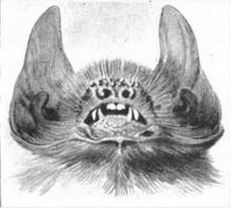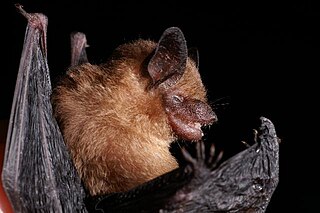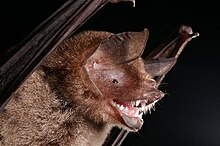
Vespertilionidae is a family of microbats, of the order Chiroptera, flying, insect-eating mammals variously described as the common, vesper, or simple nosed bats. The vespertilionid family is the most diverse and widely distributed of bat families, specialised in many forms to occupy a range of habitats and ecological circumstances, and it is frequently observed or the subject of research. The facial features of the species are often simple, as they mainly rely on vocally emitted echolocation. The tails of the species are enclosed by the lower flight membranes between the legs. Over 300 species are distributed all over the world, on every continent except Antarctica. It owes its name to the genus Vespertilio, which takes its name from a word for bat, vespertilio, derived from the Latin term vesper meaning 'evening'; they are termed "evening bats" and were once referred to as "evening birds".

Disk-winged bats are a small group of bats of the family Thyropteridae and genus Thyroptera. They are found in Central and South America, usually in moist tropical rain forests. It is a very small family, consisting of a single genus with five extant and one fossil species.

Parnell's mustached bat is an insectivorous bat native to the Americas. It ranges from southern Sonora, Mexico, south to Brazil. It has a wider historical range; fossil specimens have been collected on the island of New Providence in the Bahamas.

The big naked-backed bat, is a bat species from South and Central America.

Wagner's mustached bat is a bat species from South and Central America. It is one of the few New World bats species known to perform Doppler shift compensation behavior.

The silver-tipped myotis is a species of mouse-eared bat found in a range of lowland habitats in the Americas.

The rufous dog-faced bat, is a bat species found in Argentina, Brazil, Colombia, Guyana, Peru and Suriname.

Micronycteris is a genus of leaf-nosed bats.
Aethalops is a genus of megabats in the family Pteropodidae. It contains two species:

The eastern red bat is a species of microbat in the family Vespertilionidae. Eastern red bats are widespread across eastern North America, with additional records in Bermuda.

Davy's (lesser) naked-backed bat is a small, insect-eating, cave-dwelling bat of the Family Mormoopidae. It is found throughout South and Central America, including Trinidad, but not Tobago, Guyana, Suriname, or French Guiana. Specimens of this bat had been found infected with rabies in Trinidad during the height of that island's vampire-bat-transmitted rabies epidemic of the early half of the 20th century, but not in recent times.

Allen's yellow bat is a species of vesper bat. There is some taxonomic debate surrounding this species, with some authors considering Baeodon a genus rather than a subgenus. It is endemic to Mexico.
The sooty mustached bat is a species of bat in the family Mormoopidae. It is found in throughout the Greater Antilles, in Cuba, Hispaniola, Jamaica, and Puerto Rico.

Barbastella is a genus of vespertilionid bats. There are seven extant species in this genus and one only known from fossil remains.

Pteralopex is a genus of large megabats in the family Pteropodidae. Species in this genus are commonly known as "monkey-faced bats". They are restricted to Solomon Islands rain forests in Melanesia, and all species are seriously threatened, being rated as either endangered or critically endangered by IUCN. Two species, P. taki and P. flanneryi, have been described since 2000.

Rhogeessa is a genus of bats within the vesper bats family, Vespertilionidae.

Cynomops is a genus of Central and South American dog-faced bats in the family Molossidae. It has sometimes been considered a subgenus of Molossops. It contains the following species:















